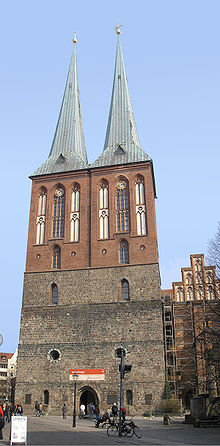St. Nicholas' Church, Berlin
| Church of St. Nicholas St. Nikolai-Kirche (de) |
|
|---|---|

|
|
| Basic information | |
| Location | Nikolaiviertel, a neighborhood of Berlin |
| Geographic coordinates | 52°31′00″N 13°24′27″E / 52.516804°N 13.407547°ECoordinates: 52°31′00″N 13°24′27″E / 52.516804°N 13.407547°E |
| Affiliation | Deconsecrated since November 1938. originally Roman Catholic, from 1539 on Lutheran. |
| District | last: March of Brandenburg ecclesiastical province, Kirchenkreis Stadt Berlin I (deanery) |
| Province | last: Evangelical Church of the old-Prussian Union |
| Country | Germany |
| Architectural description | |
| Architect(s) | unknown, Hermann Blankenstein (1877-1879) |
| Completed | ca. 1243, after burning in the city fire of 11 August 1380 reconstructed until 1470, renovation 1877-1879 |
| Materials | brick |
The St. Nikolai-Kirche, (Nikolaikirche or St. Nicholas' Church) is the oldest church in Berlin, the capital of Germany. The church is located in the eastern part of central Berlin, the borough of Mitte. The area around the church, bounded by Spandauer Straße, Rathausstraße, the River Spree and Mühlendamm, is known as the Nikolaiviertel 'Nicholas quarter', and is an area of restored mediaeval buildings (in some cases recent imitations). The church was built between 1220 and 1230, and is thus, along with the Church of Our Lady at Alexanderplatz not far away, the oldest church in Berlin.
Originally a Roman Catholic church, the Church of St. Nicholas became a Lutheran church after the Protestant Reformation in the Electorate of Brandenburg in 1539. In the 17th century, the prominent hymn-writer Paul Gerhardt was the minister of this church, and the composer Johann Crueger was musical director. The prominent Lutheran theologian Provost Philipp Jacob Spener was the minister from 1691 to 1705. From 1913 to 1923 the minister at the Church of St. Nicholas was Wilhelm Wessel, whose son Horst Wessel later became famous as a Nazi: the family lived in the nearby Jüdenstraße.
On Reformation Day in 1938 (October 31) the church building served its congregation for the last time. Then the building, the oldest structure in Berlin proper, was given up to the government, to be used as a concert hall and ecclesiastical museum. The number of parishioners had shrunk due to the ever intensifying commercialisation of the inner city with residential premises being superseded by offices and shops. The congregation later merged with that of the Church of Our Lady.
...
Wikipedia
